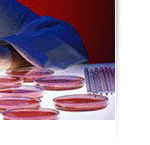Click here to go back.
HUMAN/ANIMAL HYBRID
In 2007, a debate raged in England regarding the creation of human-animal embryos. The purpose, it was argued, was to create a supply of stem cells using animal eggs, such as those from rabbits and cows. These eggs would have their DNA removed and have human cells implanted.
Riding upon the desperation of those inflicted with debilitating illness, those promoting hybrid embryos held out hopes of cures, saying that it could lead to “major breakthroughs in treatments for Alzheimer's, Parkinson's and other serious diseases.” ‘Human-animal’ embryo green light; BBC News, Sep. 5, 2007
Aligning hybrid experimentation to hopes of curing deadly diseases was key for gaining public support, as a public poll in England showed, “Some 61 percent of those asked gave their backing if the hybrids would help understand some diseases. That support fell to 35 percent if the hybrids were being created purely for nonspecific research.” Scientists Hope to Create Human-Animal Embryo; NPR news, Sep. 5, 2007
The next step was the announcement that the first hybrid embryos had been created. This was used to promote the experiments in the press, which, coincidently or not, happened at the same time the British government was debating legislation regarding hybrids. “It [the creation of hybrid embryos] comes a month before MPs [Members of Parliament] are to debate the future of such research.” UK's first hybrid embryos created; BBC News, April 1, 2008
The news coverage went international, the pressure heightened, and the British Parliament then passed the law to allow the use of hybrid embryos for research - even though it had proposed banning the practice a year earlier.
In February of 2009, the results of the experiments were reported.
“Experiments fail: Controversial human-animal hybrid embryos'will not deliver medical benefit'
Tests suggest that combining human DNA with an egg cell taken from a female rabbit or cow does not work." Daily Mail, Feb. 3, 2009
“Controversial hybrid embryos 'are no use to science' new research suggests”
“This is very disappointing because it would mean that production of patient-specific stem cells by this means would be impracticable.” The Telegraph, Feb. 3, 2009, quoting Professor Ian Wilmut, the man who cloned Dolly the sheep
“Animal-human clones don't work, U.S. company finds”
“Mixing human and animal cells does not appear to program the egg properly, said Dr. Robert Lanza of Massachusetts-based Advanced Cell Technology.”
“For the last decade, we've carried out literally hundreds of experiments trying to create patient-specific stem cells using animal eggs,” Lanza said.
“We got beautiful little hybrid embryos, but it didn't work no matter how hard we tried.
“We never had the tools before to actually look inside the cell and see what's going on,” Lanza said. It appears that using the egg of another species turns off the genes needed to make an embryo instead of turning them on.” Reuters News Service Feb. 2, 2009
The hybrid embryos were “99.9% human and 0.1% animal” (BBC News Sep. 5, 2007), as close as you could possibly get to working with strictly human embryos, and yet the experiments were a failure. This fractional variance shows that all species of animals, including human beings, are unique and incompatible genetically.
In 2001, the chief executive of Geron Inc, a biotechnology company, told the Associated Press that “living cells will be tomorrow’s pharmaceuticals.” He may very well be right, but this bright future will only be discovered if the focus is only on purely human cells.
The lesson from the failure of the hybrid embryos is that, in this new millennium, we must at last move away from using animals as substitutes for human biology, because even a 0.1% difference is an infinite chasm to bridge.
According to the MHRA report, the drug was tested using a “4 week intravenous toxicity study in cynomolgus monkeys with a 6 week observation period”.
The National Institutes for Health states on their website that “Nonhuman primates, in particular, are important for translational research because of their close physiological similarities to humans.”
Close, but so far as well. That drugs can destroy human health, yet pass safely on animals whose biology is so similar to ours, demonstrates the inherent flaw in using animals for research.
The true choice - the one that will lead to new discoveries and save lives - is the decision to leave animal research in the past and move to a future where drugs to be used on humans are tested on human cells and human tissue.







